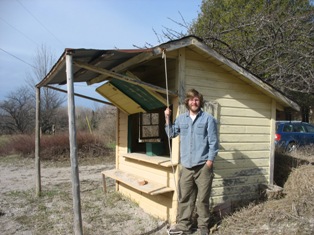From our 2011 Summer Newsletter
April 2011–On a brisk day in April, farmer Ben Brown lent a hand at a Leelanau Conservancy work bee, helping staff to remove a massive tangle of grapevines bent on engulfing the old barn at the Sonny Swanson Farm. With the aid of pruning shears and one final yank, the crew cleared the opening into the scenic old barn.
Light streamed in from slits in the weathered siding. It felt like a new beginning of sorts on the land tilled for decades by Sonny Swanson, a well-loved local character who passed away in 2008. Brown talked about how he might use that old barn – to store feed for his chickens or house a mule that would one day help till the soil on the small scale sustainable farm he envisions here.
The farm – and its landmark yellow produce stand – have stood idle since Sonny’s passing at age 89. Last year the Conservancy purchased the farm along with 90 acres – including 73 acres of wetlands and 2000 feet of shoreline on Little Traverse Lake.
One of the Conservancy’s goals in purchasing the property was to see agriculture revitalized on the 15-acre farmstead adjacent to the new 75-acre preserve. In February the organization began hearing proposals from local farmers interested in carrying on the land’s agricultural legacy.
Brown’s business plan won the favor of a committee charged to evaluate the options. “It was a hard decision,” says Director Brian Price. “We were encouraged to have a number of strong contenders who want to farm out there. Ben’s credentials and his philosophy of small scale sustainable agriculture really fit with our mission, and we’re excited to have him on board.”
The bearded, bespectacled Brown, 27, earned a degree in Ecological Agriculture from the University of Vermont in 2007. He has apprenticed or worked on seven different farms—from family operated CSAs in Pennsylvania to cherry orchards on Old Mission Peninsula. Most recently he has worked growing vegetables for Leelanau Cultured Veggies, while running his new business Haymaker Poultry Co. on rented land. He also works a part-time job delivering milk for Moomer’s.
The Conservancy’s Board recently approved a 30-month lease with an option to buy possible after 24 months, if both parties are satisfied with the arrangement at the time. As for Brown, he can’t wait to get going. “I’ve been looking for something to call my own,” says Brown. “Something permanent.” The agreement is expected to be signed soon.
Brown grew up near Chicago but spent summers on Long Lake at his family’s cottage. To earn money, he sold knives door to door, and rented jet skis. One day he drove out on Old Mission Peninsula and asked about working cherries. He was hired – and was subsequently hooked on farming. “I wasn’t in love with all the chemicals, but everything else about it was great,” he says. “My goal is to be chemical free.”
To get up and running at the Swanson farm, he’ll have help from his father, a retired builder. His mom will also take the summer off from her nursing job to pitch in. Four siblings also plan to get in on the action. Like Sonny, Brown intends to live in a newer trailer he has purchased and will park on the site – at least for three seasons. Sonny’s old trailer will be removed. If all goes well, Brown says he would like to build a home some day too.
The young farmer hopes to be stocking the famous yellow stand with at least a few varieties of vegetables this summer and is allowed to also bring in 50% of what he sells from other local farms too. But his main source of income will come from small-scale, grass-fed poultry raised on site that will also help restore the land’s fertility and eliminate the need for any fertilizer or chemicals. Chickens and turkeys will graze in the fresh air in moveable, open pens, foraging for insects, grazing on rotated crops, while simultaneously enriching the soil. The result: hormone-free, antibiotic-free chickens and turkeys he will sell right from the farm. (To receive an order form to purchase a fresh bird – available every two weeks June through October, email Ben/Haymaker Poultry Co. at shasta707@yahoo.com.)
The size of the site limits the number of birds Brown will tend to no more than 1,000 total birds annually. “I view the entire farm as one living organism,” he says. “When you tweak one part of the land, it affects the whole web. It’s important to have the right management practices in place to benefit the entire ecosystem. I will limit the stocking densities to prevent any nutrient runoff because we’ve got these precious water resources nearby.”




